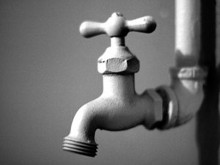Dealing With Simple Bathroom Issues and Repairs
Fall Tips and Winterizing
Cool fall temperatures serve as a reminder to prepare for the troubles that can come with extreme cold. The following simple preparations will help prevent costly repairs and repair headaches throughout the winter months.
– Disconnect outside water hoses. If left connected, water in the hoses can freeze and expand causing faucets and connecting pipes inside your home to freeze and break.
– Make sure outside faucets aren’t dripping or leaking. Make the necessary repairs or call a plumber before freezing temperatures arrive. Be aware that when pipes freeze, water pressure builds causing cracks – not matter if the pipe is made of plastic, copper or steel. Even a tiny crack can unleash more than 250 gallons of water in a single day.
If your home is equipped with interior shut-off valves leading to outside faucets, close them and drain water from the lines.
– In unheated areas, such as crawl spaces or garages, be sure pipes are insulated. Apply heat tape or thermostat-controlled heat cables around exposed pipes that may be prone to freezing
– Water heaters work harder during the winter months. This is the time of year to flush it out and remove sediment buildup which causes corrosion and shortens the lifespan of the heater and reduces heating efficiency. Drain several gallons from the faucet near the bottom of the tank. Connect a hose to the faucet and direct water into a nearby drain.
– Inspect and clean sump pump and pit Pumps exposed to extreme cold can freeze, preventing the pump from operating.
Tips for Holidays and Parties
Holidays and parties often bring more activity to your home’s plumbing and may result in excessive grease and food buildup in the kitchen drains and disposal. Holiday guests equate to more showers, baths and lots of extra toilet flushes. It takes just one major overload like a house full of guests to exasperate the situation and create a clogged drain Holiday Pipes clog because of a gradual buildup of grease, hair soap or food particles. To avoid plumbing disasters follow these tips:
Kitchen:
– Avoid pouring fats or cooking oils down the drain. Liquid fats solidify and create clogs. Wipe congealed grease from pots
– Do not put stringy, fibrous waste into the garbage disposer (poultry skins, carrots, celery, pumpkin pulp or banana peels). The disposal is not designed to grind these items and they will clog your sink drain.
– Run cold water down the drain for about 15 seconds before and after using the garbage disposal to flush waste down the main line.
– Before adding food debris, turn on the disposal.
– Avoid pushing too much food waste through the disposal at one time. Gradually feed waste while running cold water.
– Run the dishwasher and washing machine at night or at off times to conserve water temperature and pressure for your guests.
Bathroom:
– Plan ahead and plan out showers throughout the day. Wait 10 minutes between showers
– Turn up the water heater slightly to retain hot water. Do not exceed 125° to avoid scalding.
– If shower pressure is weak, pour a cup of vinegar into a plastic bag…Place it over the shower head and soak. Use a twist tie to hold it in place overnight. In the morning, remove the bag and use a small brush to gently scrub off the mineral deposits to help restore water flow.
– Provide a trash bin in the bathroom to avoid the toilet being used as a trash can. Never flush cotton swabs, cotton balls, hair, facial scrub pads, diapers, sanitary products or similar items down the toilet. They do not easily dissolve and are responsible for most clogs.
When considering the purchase of new fixtures for your home, we suggest you choose a fixture made by one of the major manufacturers, such as American Standard, Kohler or Eljer.
Recently my water bills appear to be rather high. None of my faucets appear to leak. What else could cause high water bills?
Check to see if the toilet is leaking. First, check the water level to ensure that water is not overflowing the tank by way of the overflow pipe. This is the pipe in the middle of the tank with small tubing connected to it. If water is running into the overflow, adjust the fill valve to stop the flow approximately one inch below the top of the overflow tube or to the water level mark stamped on the side of the tank.
Second, put a few drops of food coloring into the tank to test the flush valve mechanism. If the water in the bowl changes color within 15 minutes, this indicates that water is leaking into the toilet bowl and that the ball or flapper needs to be replaced. (See also General Plumbing Tips)


